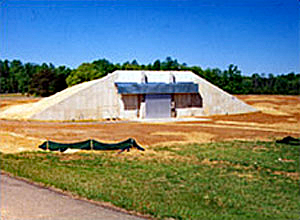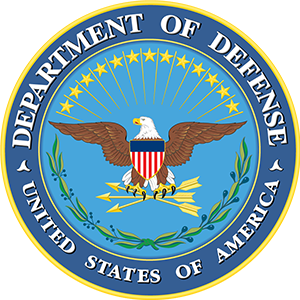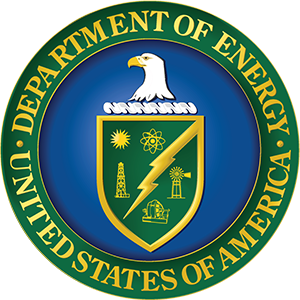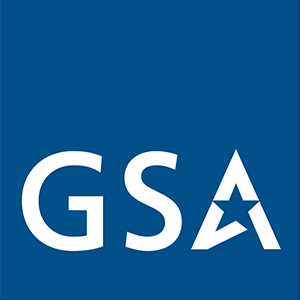Overview
Within This Page
The purpose of this Building Type page is to assist in the planning and/or design of new Ammunition and Explosive (AE) storage magazines for the Department of Defense (DoD) by providing definitions, descriptions, requirements, and standards of drawings and specifications as available. The information is intended to offer a general introduction into the design and approval of AE storage magazines. For additional information refer to the DoD Component-specific explosives safety documents and the DoD explosives safety manual referenced below.
The Department of Defense Explosives Safety Board (DDESB) has established uniform minimum AE safety standards for personnel and property that have the potential of being exposed to the effects of an accidental explosion. These standards govern the design, construction, and use of all AE storage magazines within the Department of Defense.

Earth Covered Magazine (ECM) structures are built to store AE. They are not designed to resist the damaging effects from an internal explosion, although they can effectively contain the effects from an explosion of very small AE quantities. ECMs are designed to protect their contents and prevent propagation of an explosion that may occur in an adjacent magazine. Proper siting of an ECM, from other Potential Explosion Sites (PES) and Exposed Sites (ES) including operations buildings, piers, aboveground magazines, rail sidings, classification yards, etc, ensures against unacceptable damage and injuries in the event of an accidental explosion.
Facilities are sited from a PES using the appropriate Explosive Safety Quantity- Distance (ESQD) relationship and based upon the Net Explosive Weight (NEW) at the PES.
Explosive safety standards that implement the DoD standards are contained in the following:
- Air Force: AFM 91-201
- Army: AR 385-10 / DA PAM 385-64
- DoD Contractors: DoD 4145.26-M
- Navy: NAVSEA OP 5 Volume 1 (Distribution authorized to U.S. Government agencies and their contractors; administrative/operational use; Other requests for this document must be referred to the Naval Ordnance Safety and Security Activity (NOSSA) (N5))
Description
A. ECM Designs
ECM designs fall within three basic structural hardness classifications; "7-Bar", "3-Bar" and "Undefined" depending upon the relative ability to resist blast loadings. The DDESB has established design criteria for each of the ECM classifications, and approved the classification of previously designed ECMs. DDESB Technical Paper (TP) 15Download ddesb_tp_15.pdf summarizes the development of AE storage facilities and documents approved protective construction designs.
Approved ECM designs may be site-adapted or tailored to the requirements of a specific site. Site specific tailoring primarily involves adapting the foundation and the drainage system to suit local soil and site characteristics. In addition, certain AE may require additional consideration for utilities, security, electrical, grounding, or humidity and temperature limits.
Any changes to approved designs, other than minimal site adaptation, that in any way may affect the explosive safety of the magazine design will not be used for construction without coordination and approval from the appropriate design agency and from the DDESB.
"7-Bar" (Standard) Designs A 7-Bar ECM provides the highest level of blast resistance and allows the use of the least restrictive siting separation distances. These designs may store up to 500,000 pounds NEW of hazard division 1.1, however some approved designs are based upon a lower storage capacity.
"3-Bar" Designs The headwall and doors of a 3-Bar ECM provides a lower level of blast resistance than a 7-Bar ECM resulting in more restrictive siting separation distances. A 3-Bar ECM may store up to 500,000 pounds NEW of hazard division 1.1, however some approved designs are based upon a lower storage capacity.
"Undefined" (Nonstandard) Designs An Undefined ECM provides the lowest level of blast resistance and requires the greatest siting separation distances. An Undefined ECM may store up to 500,000 pounds NEW of hazard division 1.1, however many of the designs are based upon a lower storage capacity.
B. Siting Criteria
Siting criteria for ECMs has been developed by the DDESB to define the minimum required separation distances between an ECM as a PES and ES that would be impacted from an accidental explosion. Minimum separation distances have been established between ECM and other magazines, operating buildings, inhabited buildings, and public traffic routes to ensure uniform minimum explosive safety standards for DoD facilities. Minimum separation distances are determined by the level of protection mandated by the applicable explosive safety standard, the ECM classification, the ES type, the quantity and type of AE within a PES, the physical orientation between the PES and the ES and the potential presence of barricading.
For most PES—ES orientations involving an ECM, it can be generally stated that the required siting separation distances are typically greater for a 3-Bar than a 7-Bar ECM and greater still for an Undefined ECM.
C. Approval Requirements
Plans for ECM projects must be reviewed and approved by the DDESB to ensure that minimum DoD explosive safety considerations have been addressed. Situations requiring approval include:
- New construction or major modification
- Changes in utilization of facilities that affect the siting separation distances
If pre-approved ECM designs are used, the project site plan along with the drawing numbers of the ECM design must be submitted for approval.
All new 7- and 3- Bar ECM designs must be approved by the DDESB before they can be used. The approval will require the submission of test results and/or detailed structural calculations.
All new Undefined ECM designs require approval from the DDESB to ensure minimum design and construction criteria are met.
For a description of the minimum requirements to validate explosive safety protective construction see the Department of Defense Explosives Safety Board Memorandum DDESB-PDDownload ddesb_memo.pdf , dated 21 October 2008.
D. ECM Design Resources
Previous ECM designs have been grouped into four categories described by the following tables. The tables include information related to the design of the magazines including size and maximum stowage capacity. Only the designs within the first category, Table 1, are pre-approved as 7- or 3- Bar ECM Designs for new construction. The source of these tables is DDESB TP 15.
An individual summary page for each of the approved magazine designs is linked from Table 1. Electronic drawing files in PDF format are also provided along with additional information, if available, including guide specifications, AutoCAD or Micro Station drawings that can be downloaded and tailored for site-specific conditions, DDESB approval letters, and other relevant data.
Table 1—7-Bar and 3-Bar ECM Approved for New Construction—The content of this category identifies all 7-Bar and 3-Bar ECM currently approved by the DDESB for new construction. Notes are provided to identify those ECM that have NEW limitations and/or restriction associated with their approval.
Table 2—7-Bar and 3-Bar ECM No Longer Used for New Construction, But Still in Use—The content of this category identifies all ECM designs that previously have been approved for 7- and 3-Bar siting by the DDESB, but are no longer approved for use for new construction. In most cases, these designs have not been updated to satisfy current criteria. The primary intent of this table is to assist activities in siting existing magazines. NEW limitations and/or restrictions associated with their DDESB approval must be observed. These design drawings may be used as the basis for new ECM designs, but they must not be constructed until they are updated to comply with current explosive safety requirements, current construction methods and criteria, and are reviewed and approved by the DDESB. Approved updated design drawings shall clearly identify all changes made to the original design.
If ECM designs from this table are of interest to an activity as new construction, their use must be coordinated with the DDESB to ensure acceptability prior to initiating a project.Table 3—Undefined Earth-Covered Magazines—The content of this category contains ECMs that have not been shown by analysis or testing to be capable of withstanding 7-bar or 3-bar loading. An Undefined ECM is permitted to store up to 500,000 pounds NEW of hazard division 1.1 unless noted otherwise in the table.
An undetermined ECM can be structurally analyzed in accordance with the Joint Service Manual TM5-1300/NAVFAC P-397/AFR 88-22 to determine its structural capabilities. Upon approval of the structural analysis supporting the magazine classification by the DDESB, the ECM design classification may be upgraded. For a listing of Undefined ECM designs see Table AP1-3 of DDESB Technical Paper (TP) 15Download ddesb_tp_15.pdfTable 4—Magazines (Earth-covered and Aboveground) and Containers that have reduced net explosives weight (NEW) and/or reduced quantity-distance (QD)—The contents of this category lists a number of AE storage structures and containers that have been approved by the DDESB for specific NEW and/or reduced QD. These items were generally designed for a particular application; however, as approved items, they can be used for other applications, providing all conditions, restrictions, design elements, etc., are observed. All documentation pertaining to the use of the storage structure or container must be obtained prior to their use. Table AP1-4 of TP-15 identifies restrictions or conditions for the use of these magazines or containers.
E. Typical ECM Features
A semicircular arch or oval arch constructed of reinforced concrete or steel, or a combination of the two. It could also be a reinforced concrete box-type design.
A reinforced concrete floor slab that is typically sloped for drainage.
A reinforced concrete rear wall.
Design blast loads apply to headwalls of 7- and 3-bar ECM and to the roof of box-type magazines.
A reinforced concrete headwall that extends at least 2-1/2 feet above the top of the roof. The headwall is designed to withstand the blast pressures and impulses that will be experienced as a result of an explosion in an adjacent AE storage facility. This is a critical feature that is directly associated with the strength designation assigned to an ECM.
Heavy steel doors in the headwalls (either manually operated or motorized). Approved box-type ECM may have as many as five of these doors in their headwall. Doors are either of the swinging doors or sliding type. Sliding doors are generally used on the larger ECM, while swinging doors are primarily used on smaller ECM. Doors are designed to withstand the dynamic forces from an explosion in an adjacent AE storage facility, and are therefore, a critical element of an ECM design.
Earth cover over the top, sides, and rear of the ECM. A minimum of 2 feet (24 inches) of earth cover is required over the ECM.
Reinforced concrete wingwalls on either side of the headwall. The wingwalls may slope to the ground or may join wingwalls from adjacent ECM. The purpose of wingwalls is to retain the earth fill along the side slopes of the ECM.
Lightning protection and grounding systems. Reinforcing steel in the walls, floor, and roof must be electrically continuous to provide electrical bonding between the elements and produce a faraday-like shield. Techniques commonly used and approved in the construction industry to join reinforcing steel are acceptable. The steel arch of an ECM must be similarly joined to the reinforcing steel in the floor. Minimum resistance valves apply. Other metal masses, such as ventilators, shall also be grounded and connected to a common earth electrode system such as a buried ground girdle.
Incoming utilities are installed to meet the material, installation, grounding, and lightning surge protection criteria.
When required, internal electrical work and equipment must be rated for the hazardous environments expected within the ECM.
In the case of a box-type ECM, the walls and roof may be constructed of reinforced concrete or of prefabricated concrete panels that are assembled in the field. Earth cover, lightening, and grounding criteria described above also applies to box-typed ECM.
F. ECM Types
Listed below are the descriptions of the cross-section of magazines.
Arch—Also known as a circular arch. A single radius is used to define the interior face of the arch, which may be constructed of reinforced concrete, steel (corrugated, laminated, or single gage), or a combination of reinforced concrete and steel to form a composite arch (steel interior arch with overlying concrete).
Arch, Oval—This arch is in the shape of an oval, with the lower portion of each sidewall bowing in towards the direction of the centerline. The arch can be constructed of steel, reinforced concrete, or a composite of both. The shape is defined by the use of a single radius for the majority of the arch, with a separate radius called out for the lower portions of the arch. The modified FRELOC-Stradley ECM design is an example of an oval-arch ECM.
Arch, Semi-Circular—The sidewalls are elongated with the arch defined by a radius that originates approximately 3 to 5 feet above floor level. A radius originating at the opposite sidewall defines the lower portion of the arch. The arch can be constructed of either reinforced concrete or steel.
Stradley—This reinforced concreted ECM is characterized by vertical sidewalls that blend into the arched roof. Three radii are used to define the arch and the transition from the vertical sidewalls to the roof arch. Another feature of the Stradley ECM is that its walls are significantly thicker at the base of the sidewalls and thinner at the crown of the arch. There are currently no Stradley designs approved for new construction.
FRELOC-Stradley—The FRELOC-Stradley ECM is constructed of reinforced concrete. Its interior shape is similar to a Stradley ECM, except that the sidewalls and arch have the same thickness.
Modified FRELOC-Stradley—This ECM design was the first ECM constructed with an oval arch. See the information above for the oval arch. There are currently no Modified FRELOC Stradley designs approved for new construction.
Box—This term describes any ECM that has an internal box shape. Explosives limits can range from less than a pound NEW of hazard division 1.1 to 500,000 pounds NEW hazard division 1.1.
Dome—The domed shape is used for only the Corbetta ECM design. The interior wall is approximately three times the height of the magazine. There are currently no Dome designs approved for new construction.
G. ECM Selection
The selection of an ECM is based primarily on the type and quantity of AE that will be stored in the magazine and the cost of construction. Siting restrictions, potential operational considerations, AE compatibility, and other considerations may also factor in the selection of the magazine.
Individual summary sheets for each of the approved 7- and 3- Bar ECM designs within Table 1 are provided to help in the selection process. The information provided in the summary sheets include the physical dimensions of the magazine, approved drawing number, number and size of doors, maximum NEW storage capacity, and comments related to the use of the design.
Individual services may also provide additional guidance on the selection of magazine designs.
Suggested storage layout plans for various AE within many of the approved magazine designs are available to assist in the effective use of the magazine and as a tool to estimate the potential stowage capacity. The U.S. Army Technical Center of Explosives Safety (USATCES) develops and maintains several tools and documents related to the storage of AE.
- NAVSEAINST 8024.2
- U.S. Army Command drawings 19-48-75-5
H. Barricades
Barricades are protective structures that can act as a barrier between a PES and an ES. When properly sited and constructed they are an effective protection against low angle fragments and for reducing shock overpressures near the barricade. To protect against low angle fragments barricades must be high enough to intercept the ballistic trajectories of fragments and thick enough to reduce the fragment velocity to acceptable levels.
Army Definitive Drawings for Barricades Standard Design (Drawing Code DEF 149-30-01) illustrates several conceptual barricade designs utilizing various construction materials. For additional information see DoD Explosives Safety or the applicable service explosive safety standards.
Relevant Codes and Standards
- AR 385-10 The Army Safety Program by Department of the Army.
- AFM 91-201 Explosives Safety Standards by HQ USAF/SE.
- DA PAM 385-64 Explosives Safety Standards by Department of the Army.
- DoD 4145.26-M DoD Contractors' Safety Manual for Ammunition and Explosives by Under-Secretary of Defense for Acquisition and Technology.
- DESR 6055.09 Defense Explosives Safety Regulation by Under-Secretary of Defense for Acquisition and Sustainment
- NAVSEA OP 5 Volume 1 Ammunition and Explosives Safety Ashore, Department of the Navy, Naval Sea Systems Command (Distribution authorized to U.S. Government agencies and their contractors; administrative/operational use; Other requests for this document must be referred to the Naval Ordnance Safety and Security Activity (NOSSA) (N5)).
Additional Resources
Websites
- The Air Force Sustainment Center
- The Defense Ammunition Center
- The Naval PHST Center
- The Naval Safety Center
- The U.S. Army Engineering and Support Center, Huntsville, AL
- The U.S. Army Technical Center for Explosives Safety
Publications
- DDESB TP 15 Approved Protective ConstructionDownload ddesb_tp_15.pdf by Department of Defense Explosive Safety Board.
- DDESB-PD Memorandum, 21 Oct 2008, Minimum Requirements to Validate Explosives Safety Protective ConstructionDownload ddesb_memo.pdf by Department of Defense Explosives Safety Board.
- EP 1110-345-102 Engineering and Design Explosives Storage MagazinesDownload EP_1110-345-102.pdf by Department of the Army, Army Corps of Engineers.
- NAVSEAINST 8024.2 Magazine Stowage Layout Standards by Department of the Navy, Naval Sea Systems Command.
- TM 5-1300/NAVFAC P-397/AFR 88-22 Structures to Resist the Effects of Accidental Explosions by Departments of the Army, the Navy, and the Air Force.
- U.S. Air Force Munitions Facilities Standards Guide, Vol. 1
- U.S. Air Force Munitions Facilities Standards Guide, Vol. 2
- U.S. Army Material Command Drawings 19-48-75-5 by U.S. Army Ammunition Center and School (USADACS).










